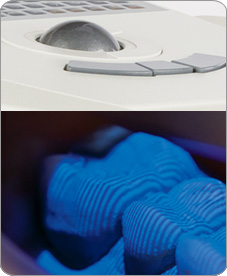
 Q. What are the differences between the previous version of CEREC software and the new CEREC Biogeneric software?
A. In previous versions of the software, we would use different databases of teeth to replace missing tooth structure. This worked well, but it was not specific to that particular patient. It was basically a philosophy of morphing a denture tooth to fill a space.
Using Biogenerics, the software is analyzing the patient’s own teeth and creating occlusal morphology that is perfect for that particular patient. This process is based on mathematical algorithms that are scientifically exact and reproducible.
Think about face recognition software, upon which Biogenerics is based. If you’ve ever watched the television show CSI, sometimes they will be able to generate an entire face based on a few data points on a suspect’s ear. Biogenerics works on the same concept, except we are constructing teeth based on that patient’s genetic makeup. Any software can use a database process – the Biogeneric process is exclusive to Sirona and protected by patent.
Q. What are the differences between the previous version of CEREC software and the new CEREC Biogeneric software?
A. In previous versions of the software, we would use different databases of teeth to replace missing tooth structure. This worked well, but it was not specific to that particular patient. It was basically a philosophy of morphing a denture tooth to fill a space.
Using Biogenerics, the software is analyzing the patient’s own teeth and creating occlusal morphology that is perfect for that particular patient. This process is based on mathematical algorithms that are scientifically exact and reproducible.
Think about face recognition software, upon which Biogenerics is based. If you’ve ever watched the television show CSI, sometimes they will be able to generate an entire face based on a few data points on a suspect’s ear. Biogenerics works on the same concept, except we are constructing teeth based on that patient’s genetic makeup. Any software can use a database process – the Biogeneric process is exclusive to Sirona and protected by patent.
ARTICLE TOOLS
 PRINT PRINT
 SHARE SHARE
Up until CEREC Biogeneric, you were able to construct biogeneric inlays and onlays using the remaining tooth structure as the basis of occlusal surface calculations. In the new software you can now do crowns, veneers and anatomically sized bridges by using the occlusal and lateral surfaces of an intact tooth as a basis. This can be the antagonist, neighboring or contra-lateral tooth.
Q. What are the biggest advancements in CEREC Biogeneric?
A. The general process of using the software has remained the same. However, there are two major advancements in this software with buccal bite and biogeneric crowns, both patented technologies exclusive to Sirona.
No. 1 is the new buccal bite. For the first time we are able to scan the actual opposing dentition and articulate that with the preparation model by means of a buccal bite image in centric occlusion. The accuracy of this articulation is truly astounding and it has made manipulating occlusion in the software a breeze. The introduction of this feature has made Sirona the only chairside system on the market that is now truly impression-free. Getting rid of the bite registration has made occlusion dramatically easier and has almost eliminated post-insertion adjustments of the restoration.
No. 2 is the biogeneric proposals. Using genetic information stored in patients’ existing teeth to create natural occlusions has really reduced the need for adjustments. The proposals are almost perfect every time and the occlusion is absolutely spot on.
|
|
| |
|
|
© 2025 Patterson Dental. All rights reserved.